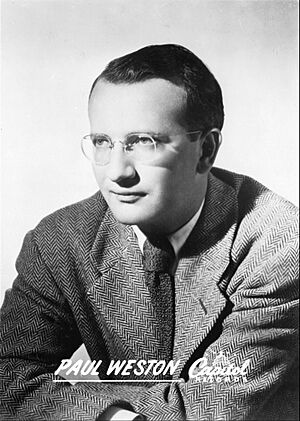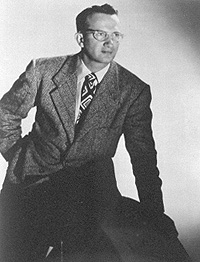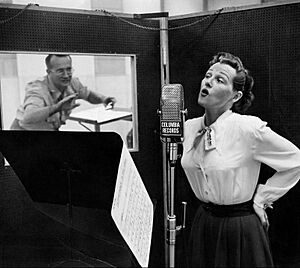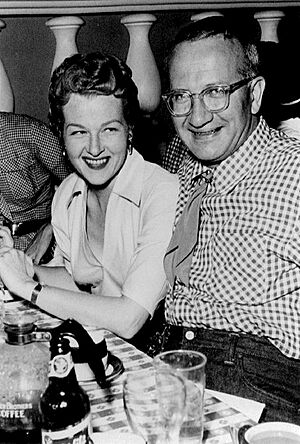Paul Weston facts for kids
Quick facts for kids
Paul Weston
|
|
|---|---|

Paul Weston at Capitol Records, 1940s
|
|
| Background information | |
| Birth name | Paul Wetstein |
| Born | March 12, 1912 Springfield, Massachusetts, U.S. |
| Died | September 20, 1996 (aged 84) Santa Monica, California |
| Genres | Jazz, easy listening, pop |
| Occupation(s) |
|
| Instruments | Piano |
| Years active | 1933–1970s |
| Labels | Capitol Columbia, Corinthian |
| Associated acts | Jonathan and Darlene Edwards |
Paul Weston (born Paul Wetstein; March 12, 1912 – September 20, 1996) was a talented American musician. He played piano, wrote songs, and led orchestras. He worked in music and TV from the 1930s to the 1970s. People called him "the Father of Mood Music." This was a new style of calm, background music. He wrote popular songs like "I Should Care" and "Day by Day". He also wrote classical music and hymns.
Paul was born in Springfield, Massachusetts. He loved music from a young age. He learned to play the piano. He went to Springfield High School. Later, he studied at Dartmouth College and Columbia University.
At college, Paul started his own band. He also played with the college band. He joined Columbia's dance band, The Blue Lions. After a train accident, he could not perform for a while. During this time, he started writing music arrangements. He sold his first arrangements in 1934. His music was heard by Rudy Vallée, a famous radio star. Vallée offered Paul a job on his radio show. Paul met Tommy Dorsey, a famous bandleader. In 1936, Paul joined Dorsey's orchestra. He helped Dorsey hire a singing group called The Pied Pipers.
Paul left Dorsey's band in 1940. He then worked with singer Dinah Shore. He moved to Hollywood for film work. In California, he met Johnny Mercer. Mercer asked Paul to write for his new company, Capitol Records. Paul became the music director there. He worked with singer Jo Stafford and helped create "mood music." Stafford later joined him at Columbia Records in 1950. They got married in 1952.
Paul worked a lot in television from the 1950s to the 1970s. He helped start the Grammy Awards in 1959. He received a special Grammy award in 1971. He also worked as a music director for "Disney on Parade."
Paul and Jo Stafford created a funny act. They pretended to be a terrible lounge act called Jonathan and Darlene Edwards. Their first album came out in 1957. In 1960, their album Jonathan and Darlene Edwards in Paris won a Grammy Award. Paul Weston has a star on the Hollywood Walk of Fame. This honors his work in music.
Contents
Paul's Early Life and Career
Paul Weston was born Paul Wetstein. His parents, Paul Sr. and Anna, loved music. The family moved to Pittsfield, Massachusetts when Paul was two. He grew up there. His father taught at a girls' school. He sometimes brought the school's record player home. Paul remembered hearing music on it as a child.
Learning Music and College Years
Paul started piano lessons when he was eight. He studied economics at Dartmouth College. He did very well, graduating with honors in 1933. While in college, Paul had his own band. It was called "the Green Serenaders." This band helped him pay for his college tuition. He also learned to play the clarinet. This allowed him to travel with the college band.
After Dartmouth, he went to Columbia University. He played in Columbia's dance band, The Blue Lions. In January 1934, Paul had a serious train accident. He was trying to catch a train. He grabbed a door handle as it sped away. He held on for a long time before letting go.
Starting as an Arranger
Because of his injuries, Paul could not play in a band. He started writing music arrangements instead. This let him stay involved with music. When he returned to New York in 1934, he sold his first work. He sold it to Joe Haymes, a bandleader. Haymes liked Paul's work and asked for more.
Paul's music was heard by Rudy Vallee. Vallee offered Paul a job as an arranger. This was for his radio show, The Fleischmann's Yeast Hour. Paul also arranged music for Phil Harris. He met Tommy Dorsey through Joe Haymes. In 1936, Paul became the main arranger for Dorsey's orchestra. He worked with Dorsey until 1940.
Moving to Hollywood
After leaving Dorsey, Paul became the arranger for Dinah Shore. He also worked for the Bob Crosby Orchestra. Paul worked on radio shows like Fibber McGee and Molly. When Bob Crosby's band worked on the film Holiday Inn, Paul went to Hollywood. He started working in films. He changed his name from Wetstein to Weston after moving to California. Paul did more film work for Bing Crosby and Bob Hope. He also worked for Betty Hutton. He was the musical director for films like Belle of the Yukon (1944) and Road To Utopia (1945).
Working at Capitol and Columbia Records
Paul Weston met Johnny Mercer in 1942. Mercer was starting Capitol Records. He wanted Paul to write music for his new company. Paul wrote and arranged "Strip Polka" for Capitol. This was one of the first songs for the new label.
In August 1942, a musicians' strike began. Musicians could not record for record companies. This stopped Capitol from making new music. To help, Johnny Mercer started a radio show. It was called Johnny Mercer's Music Shop. This show featured Capitol's artists. Mercer and singer Jo Stafford hosted the show. Paul Weston and his orchestra provided the music.
Meeting Jo Stafford
Paul and Jo Stafford first met in 1938. Paul was working for Tommy Dorsey then. Paul helped Jo's group, the Pied Pipers, get an audition with Dorsey. The recording ban ended for Capitol in October 1943. Paul could then return to the recording studio. In 1944, he became Capitol's music director. He was the youngest music director for a major record company.
Developing Mood Music
Besides his work at Capitol, Paul conducted for many radio shows. He worked on Duffy's Tavern and Your Hit Parade. Jo Stafford became a regular host of the Chesterfield Supper Club. Paul and his orchestra often played on her show.
Around this time, Paul had a new idea for music. He wanted to create music like a movie soundtrack. It would be pleasant background music. His album Music For Dreaming started the "Mood Music" style. In 1950, he moved to Columbia Records. Jo Stafford also signed with Columbia. Paul continued to be active in radio. He had his own show, The Paul Weston Show.
Paul Weston and Jo Stafford married on February 26, 1952. They had two children, Tim (born 1952) and Amy (born 1956). They both returned to Capitol in 1961. They later left for Dot Records in 1965.
Jonathan and Darlene Edwards
In 1957, Paul Weston became a music director for NBC-TV. He held this job for five years. He also helped start the National Academy of Recording Arts and Sciences. This group gives out the Grammy Awards.
Paul and Jo had a funny act they did at parties. Paul would play the piano badly. Jo would sing off-key. They decided to record this act. They called themselves Jonathan and Darlene Edwards. A record executive chose the name Jonathan Edwards for Paul. Paul was worried he could not fill an album alone. So, he asked Jo to help. She became Darlene Edwards, the off-key singer.
At first, no one knew who was behind the records. People guessed which famous people it might be. Then, a 1957 Time magazine article revealed their true identities.
In 1958, the fictional couple appeared on Jack Benny's TV show. In 1960, they were on The Garry Moore Show. They won a Grammy Award for Best Comedy Album in 1960. While Paul was the conductor for The Danny Kaye Show, Jonathan Edwards appeared on it. He sang "I Love a Piano" with Danny Kaye.
They continued to release Jonathan and Darlene albums. In 1979, they covered "Stayin' Alive" by The Bee Gees. Their last album was Darlene Remembers Duke, Jonathan Plays Fats in 1982.
The Grammy Awards
The idea to honor people in the recording industry started in 1957. The Hollywood Chamber of Commerce wanted to place bronze stars on Hollywood Boulevard. This became the Hollywood Walk of Fame. They asked music executives for a list of deserving people. Paul Weston was on this committee.
The committee decided that artists who sold many records should get a star. But they realized many important people would not qualify. This led to the creation of the National Academy of Recording Arts and Sciences. Their goal was to create a new award for recording artists. This award became known as the Grammy. The first Grammy Awards were given in 1959. Paul Weston received a special Trustees' Award Grammy in 1971. This honored his dedication to music.
Television Work and Compositions
Paul Weston had a long career as a music director for television. He worked on The Danny Kaye Show and The Jonathan Winters Show. He also worked on The Jim Nabors Show. From 1954 to 1955, he was the conductor for his wife Jo Stafford's CBS TV show. Paul once joked that conductors on live TV shows should get extra pay for stunts. In 1959, Paul worked on a children's TV special. It was called Art Carney Meets Peter and the Wolf. He was nominated for an award for his music on the show.
Songs Paul Wrote
Paul arranged Ella Fitzgerald's album Ella Fitzgerald Sings the Irving Berlin Songbook (1957). This album featured songs by Irving Berlin. Paul also wrote many songs himself. These include "I Should Care" and "Day by Day". He wrote these with Sammy Cahn and Axel Stordahl. These songs were big hits for Frank Sinatra. Paul also helped write "Shrimp Boats" in 1951. This song became popular when Jo Stafford sang it.
One of Paul's songs made a tiny town famous. While visiting Maui, Hawaii, Paul needed gifts for his children. He went to the Hasegawa General Store. He later wrote a song about it called "The Hasegawa General Store." Arthur Godfrey and Jim Nabors recorded this song.
Classical and Religious Music
Paul also wrote classical and religious music. One of his symphonic pieces is Crescent City Suite. It has been performed many times, especially in New Orleans. He wrote it in 1956. A version for school bands was made in 1959. He also wrote many hymns and two Masses. These were published by the Gregorian Institute of America.
In the late 1970s, Paul started Corinthian Records. This company first released religious music. Later, it also distributed Paul and Jo's other albums. Paul wanted to get the original recordings of his and Jo's music. This was so they could be released on compact disks later. He also spent three years as the music director for Disney on Parade.
Retirement and Legacy
Paul and Jo Stafford stopped performing in the 1970s. They spent more time helping charities. These groups helped people with developmental disabilities. A work center in Woodland Hills, California is named after Paul Weston.
Paul Weston passed away on September 20, 1996, in Santa Monica, California. He was 84 years old. He is buried in Holy Cross Cemetery, Culver City. In 2006, Jo Stafford donated her husband's music library to the University of Arizona. She passed away in 2008.




